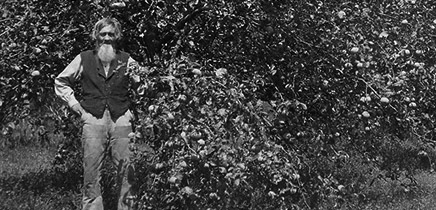Carver County, founded in 1855, is home to the Minnesota and Crow rivers, along with 125 lakes. Located southwest of the Twin Cities, it is part of the seven county metro area.
Early Residents
The area named Carver County has been home to American Indians, immigrants, and many others throughout its long history. Many thousands of years ago, Minnesota was covered by glaciers and the First People, early American Indians, who hunted mammoths and giant bison. As the ice melted, the people changed how they hunted and lived. They made their own tools from bone or rock. This process is called flintknapping. Most hunted with spears or bow and arrow. Trade with neighboring groups was important, but trade also stretched across the country. Archaeologists found a cowry shell, an object found in the Pacific Ocean, in a Carver County archaeology site in Camden Township.
Over time, Minnesota became a forest, of oak, elm, maple and cottonwood trees. The “Big Woods” covered much of Minnesota and Wisconsin. This forest provided good hunting grounds for the American Indians in the area, who were mainly Dakota. The Indians traveled with the seasons. They followed deer and elk herds and gathered fruits, nuts and berries. The Dakota had a lasting impact on Carver County, and Dakota place names, such as Waconia (lake of the fountain or lake of the spring) and Chanhassen (tree of sweet sap) identify important areas.
The Fur Trade
Some of the first European explorers in the area that became Carver County were French. They created strong relationships with the American Indians, learning the knowledge and skills.Massachusetts-born Jonathan Carver lived with a local band over a period of months, learning Dakota culture and writing about what he learned.
The Indians saw value in items the French brought with them such as axes, guns, and glass beads. These items were not commonly available and gave advantages to the Dakota. The Indians brought early explorers and later French traders into their kinship system to create better on-going trade relations. The French traders married Indian women and learned their language and traditions, becoming part of a pre-existing trade network.
From the late 1600s through the 1840s, growing numbers of Europeans came into Minnesota to trade fur. In Carver County, there were two companies in the fur trade: the Northwest Fur Trading Company (British), and the American Fur Company. The Northwest Fur Company started in 1779, and there is archaeological evidence of a fur trading post associated with them located in Carver County. The post was south of where the city of Carver sits, along the Minnesota River, at a location called “Little Rapids”. It was operated from 1804-1808, and again in the 1830s, by Jean-Baptiste Faribault. It was run with help from his wife Pelagie, and sons Alexander and Oliver. In the twenty-first century, a historic marker is near the site, as no structures remain.
The British controlled the fur trade in the late 1700s and then the Americans took over in the early 1800s. The Indians tried to create the same family bonds with them as they had with the French. They referred to “Grandmother England” and “The Great Father in Washington.” However, the British and the Americans did not understand the importance of family to the Dakota. Indian-White relations declined. The fur trade period effectively ended in 1851 with the signing of two important treaties.
Treaty Period
The Treaty of Traverse de Sioux was signed July 23, 1851, and the Treaty of Mendota signed in August 1851, with the Sisseton/Wahpeton bands (Traverse de Sioux) and Wahpekute/Mdewakanton bands (Mendota) of Dakota. These treaties opened what is now Carver County to settlement by white settlers. Many whites had settled the land prior to the treaties, illegally. These illegal settlers are sometimes known as “Sooners”, and many of them were forced to give up their land. They either moved back east again or made their homes on different land, legally.
Settlement of Carver County
Carver County became an official county on March 3, 1855, named for early explorer, Jonathan Carver, as is the city of Carver. It is divided into ten townships: Hollywood, Watertown, Camden, Waconia, Laketown, Young America, Benton, Dahlgren, Hancock, and San Francisco. Government officials declared San Francisco the first county seat until it was moved to Chaska in 1856. It remains in Chaska even with many battles to move the county seat to other locations.
By 1857, five school districts were organized: Carver, Chaska, Benton, Chanhassen, and Groveland. The very first school was located in Chanhassen, where the University of Minnesota Landscape Arboretum sits. The teacher was Susan Hazeltine. Lake Susan and Hazeltine Golf course are named after her.
The earliest white settlers were from the eastern United States. By the 1860s, however, most new settlers were immigrants from Germany, Ireland, or Sweden. This immigrant population brought their home country traditions, including names for their new towns. The Germans brought names like Hamburg, Gotha, and Cologne, and the Swedes, Swede Lake and East Union.
Most settlers wanted to own land and became farmers, but Chaska also had a booming brick industry, known for its distinctive yellow brick. The thickness of the Big Woods made it difficult for early settlers to clear the land for farming, but they carried on, using cut trees for houses, firewood, and tools. The desire to clear the land led to a booming logging industry in the 1850s-1870s. In the early twenty-first century, much of the county’s land is still farmland. Most people, though, hold other types of work, with many making the drive to the Twin Cities and surrounding communities for work.
Carver County in the Twenty-First Century
At the beginning of the twenty-first century, a Board of Commissioners, each taking one of five districts, governs Carver County. These Commissioners guide the directives, resolutions, ordinances, and policies for all of Carver County, implemented by the County Administrator’s office. The County Administrator’s department also guides and supports all other county divisions, such as Social Services and Public Health and Environment.
The county sits among Wright County (north), Hennepin County (northeast), Scott County (southeast), Sibley County (southwest) and McLeod County (west). Carver County has a total area of approximately 376 square miles, of which around ninety-five percent (357 square miles) is land, and about five percent (nineteen square miles) is water. The land of Carver County consists of plains, gently rolling to steep hills, wetlands, streams, and lakes, with steep bluffs along the Minnesota River Valley. The county is home to many parks, protected wetlands, and nature preserves, among them: Seminary Fen, Baylor Regional Park, and Carver Park Reserve.
While small, Carver County has been one of the fastest growing counties in Minnesota since about 1980. Carver County has a large urban/rural, or city/country, divide. The eastern cities of Chaska and Chanhassen combine for over half of the county’s population. Waconia and Victoria follow these cities closely. The other eleven towns have populations less than half this size.
Though the county is ninety-four percent white in the early twenty-first century, numbers of minority residents are growing. Chaska in particular has seen major growth of its Hispanic population. This growing racial and ethnic diversity is very visible in the public schools. Throughout Carver County, a growing percentage of students speak a language other than English at home.
Overall, Carver County has a long and rich history. It is well positioned to continue to thrive.
Turning Point: Carver County is established by the state of Minnesota on March 3, 1855.
Chronology:
- late 1600’s- Fur trade between American Indians and the French begins in what is later known as Carver County.
- 1804-1808- Jean-Baptiste Faribault runs Little Rapids Fur trade post. He and his family return to it in the 1830’s.
- 1851- Signing of treaties at Traverse de Sioux and Mendota in July and August. These treaties officially open up the land that becomes known as Carver County to white settlement.
- March 3, 1855- Carver County is officially established, with San Francisco named as the county seat.
- 1855: First official road created in Carver County, in Dahlgren.
- 1856: Chaska becomes the county seat.
- 1857: The brick industry in brick industry in Chaska begins, lasting for over one hundred years.
- 1870s: The logging industry starts to slow in Carver County
- 1912-1916: The Yellowstone Trail, the first “good road” connecting the east and west coasts of the United States, is designated and improved in Carver County. In 1926, it would become parts of Hwys. 5 and 212 through the county.
Maps:
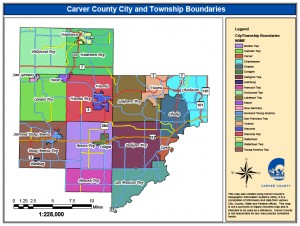
Download a pdf of this image:Carverco_City_and_Township_boundaries
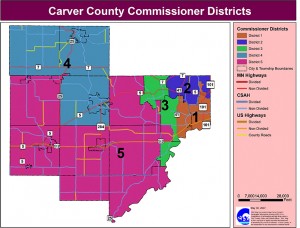
Download a pdf of this image: Commissioner_Districts2
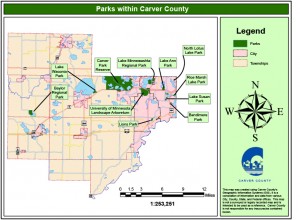
Download a pdf of this image: Carverco_Parks
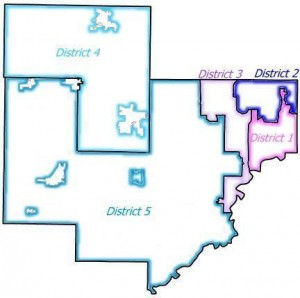
BIBLIOGRAPHY
Carver County website. About. Accessed December 1, 2012. http://www.co.carver.mn.us/county_government/aboutCC.asp
Carver County website. Board of Commissioners. Accessed December 1, 2012. http://www.co.carver.mn.us/county_government/board.asp
Carver County website. Carver County 2030 Comprehensive Plan. Accessed December 1, 2012. http://www.co.carver.mn.us/departments/LWS/2030_plan.asp
DNR website. Lake Finder: Carver County. Accessed December 2, 2012. http://www.dnr.state.mn.us/lakefind/index.html
Petersen-Biorn, Wendy. “Yellowstone Trail: Remembering the ‘Good Road’”. Chaska Herald, September 2, 2012.
Minnesota Indian Affairs Council website. Accessed February 23, 2013. http://www.indianaffairs.state.mn.us/
Minnesota Humanities Center website. Why Treaties Matter exhibit. Accessed February 23, 2013. http://www.minnesotahumanities.org/treaties
Ridge, Alice A. and John William. Introducing the Yellowstone Trail: A Good Road from Plymouth Rock to Puget Sound, 1912-1930. Altoona, WI: Yellowstone Trail Publishers, 2000.
Treaties Matter website. Explore Treaties. Accessed February 23, 2013. http://www.treatiesmatter.org/treaties
Warner, George E. and Charles M. Foote. History of the Minnesota Valley: Carver County. Reprint. Carver County Historical Society, 1986. Originally published in George E. Warner and Charles M. Foote, History of the Minnesota Valley, Minneapolis: North Star Publishing Company, 1882.
RELATED RESOURCES
Secondary:
Barac, Lavonne. Chaska:A Minnesota River City, Volume 1 and 2. St. Paul, MN: Carver County Public Library, 1989.
“Book Reviews”. Minnesota History Magazine, Winter 1997-1998, Vol. 55 Issue 8: 374-380.
Carver County Historical Society. ”Farmhouses in Carver County: Resources Worthy of Preservation”.
Brochure, Minnesota Department of Transportation, April 2011.
Chaska Historical Society. “Chaska Brick: 1857-1950”. Pamphlet. Information gathered from: City of Chaska- Historic Context Study, Prepared for the Chaska Heritage Preservation Commission by Thomas R. Zahn and Associates. Bethany Gladhill, Project Associate, Spring 2006.
Carver County: Today and Yesterday. Compiled by the Carver County Statehood Centennial Committee, 1958.
Fuller, Wayne Edison. One-Room Schools of the Middle West: An Illustrated History. Lawrence, KS: University Press of Kansas, 1994.
Holcombe, Maj. R.I., editor. Compendium of History and Biography of Carver and Hennepin Counties, Minnesota. Henry Taylor and Company: Chicago, 1915.
“Life in Carver County.” Carver County Citizen. 7 no. 2 (December 2006): 1-4.
Lofstrom, Ted and Lynne VanBrocklin Spaeth. Carver County: A Guide to Its Historic and Prehistoric Places. St. Paul: Minnesota Historical Society Press, 1978.
Martens, Steve C. “Historic Chaska, Minnesota: “Minnesota’s Brick City”: Downtown Preservation Design
Manual. Prepared for the: Chaska Heritage Preservation Commission, 2003.
Martens, Steven C. “Ethnic Traditions and Innovations as Influences on a Rural Midwestern Building
Vernacular”. Master’s thesis, University of Minnesota, 1988.
Martins, Steve. “Brick Houses in Carver County”. Student paper, University of Minnesota-Foster Dunwiddie Papers, 1987-1988.
Overcott, Nancy. At Home in the Big Woods. Lanesboro, MN: Taxon Media, 2002.
Theen, Olive Ireland. Country School Days: The Vanished One Room School. St. Cloud, MN: self-published through Sentinel Print, Co., 1992.
Theobald, Paul. Call School: Rural Education in the Midwest to 1918. Carbondale, Ill.: Southern Illinois University Press, 1995.
Tremblay, Ruth and Lois Schulstad. Images of America: Carver County. Arcadia Publishing: Charleston, South Carolina, 2011.
Winchell, N.H. “Notes on the Big Woods”. Annual Report of the Minnesota State Historical Society, 1875.
Web:
Carver Co. City and Township Boundaries. Carver County Free maps, Carver County GIS, Chaska: http://www.co.carver.mn.us/departments/admin/IS/free_maps.asp Description: Map showing the division of Carver County into townships, cities and towns. Rights: Carver County GIS.
Carver County ParksCarver County Free maps, Carver County GIS, Chaska: http://www.co.carver.mn.us/departments/admin/IS/free_maps.asp Description: Map showing the division of Carver County into townships, cities and towns. Rights: Carver County GIS.
Carver County Commissioner Districts Carver County Free maps, Carver County GIS, Chaska: http://www.co.carver.mn.us/departments/admin/IS/free_maps.asp Description: Map showing the division of Carver County into townships, cities and towns. Rights: Carver County GIS.
“This article used with the permission of MNopedia, operated by the Minnesota Historical Society, under a Creative Commons License. No changes have been made to the article’s content.”

